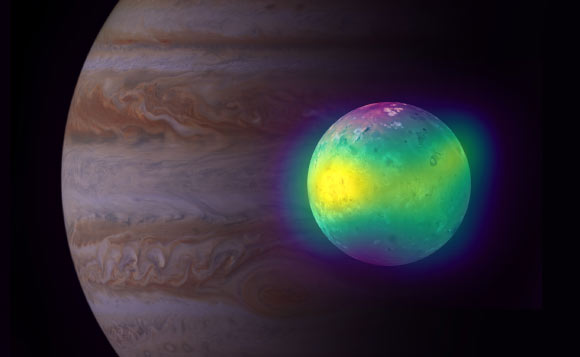Astronomers using the Atacama Large Millimeter/submillimeter Array (ALMA) have spotted airborne plumes of sulfur dioxide (SO2), sulfur monoxide (SO), and potassium chloride (KCl) from Io’s active volcanoes.
Source: Sci News
Jupiter’s satellite Io is unique amongst planetary bodies in the Solar System.
It hosts more than 400 active volcanoes, spewing out sulfur gases. Its yellow-white-orange-red coloration is produced by sulfur dioxide-frost on its surface, elemental sulfur and a variety of sulfur allotropes.
Io has a think atmosphere that can teach us about the moon’s volcanic activity and provide us a window into the exotic moon’s interior and what is happening below its colorful crust.
“It is not known which process drives the dynamics in Io’s atmosphere,” said Dr. Imke de Pater, an astronomer at the University of California, Berkeley and the Delft University of Technology.
“Is it volcanic activity, or gas that has sublimated from the icy surface when Io is in sunlight?”
To distinguish between the different processes that give rise to Io’s atmosphere, Dr. de Pater and colleagues used ALMA to capture radio images of the moon when it went from sunlight into eclipse (March 20, 2018), and vice versa (September 2 and 11, 2018).
“When Io passes into Jupiter’s shadow, and is out of direct sunlight, it is too cold for sulfur dioxide gas, and it condenses onto Io’s surface,” said Dr. Statia Luszcz-Cook, an astronomer at Columbia University.
“During that time we can only see volcanically-sourced sulfur dioxide. We can therefore see exactly how much of the atmosphere is impacted by volcanic activity.”
The team could clearly see the plumes of sulfur dioxide and sulfur monoxide rising up from the volcanoes.
Based on the ALMA images, they calculated that active volcanoes directly produce 30-50% of Io’s atmosphere.
The images also showed a third gas coming out of volcanoes: potassium chloride.
“We see potassium chloride in volcanic regions where we do not see sulfur dioxide or sulfur monoxide,” Dr. Luszcz-Cook said.
“This is strong evidence that the magma reservoirs are different under different volcanoes.”
Io is volcanically active due to a process called tidal heating.
It orbits Jupiter in an orbit that is not quite circular and, like our Moon always faces the same side of Earth, so does the same side of Io always face Jupiter.
The gravitational pull of Jupiter’s other moons Europa and Ganymede causes tremendous amounts of internal friction and heat, giving rise to volcanoes such as Loki Patera, which spans more than 200 km (124 miles) across.
“By studying Io’s atmosphere and volcanic activity we learn more about not only the volcanoes themselves, but also the tidal heating process and Io’s interior,” Dr. Luszcz-Cook said.
The findings will be published in the Planetary Science Journal.
Source: Sci News

































Leave a Comment
You must be logged in to post a comment.